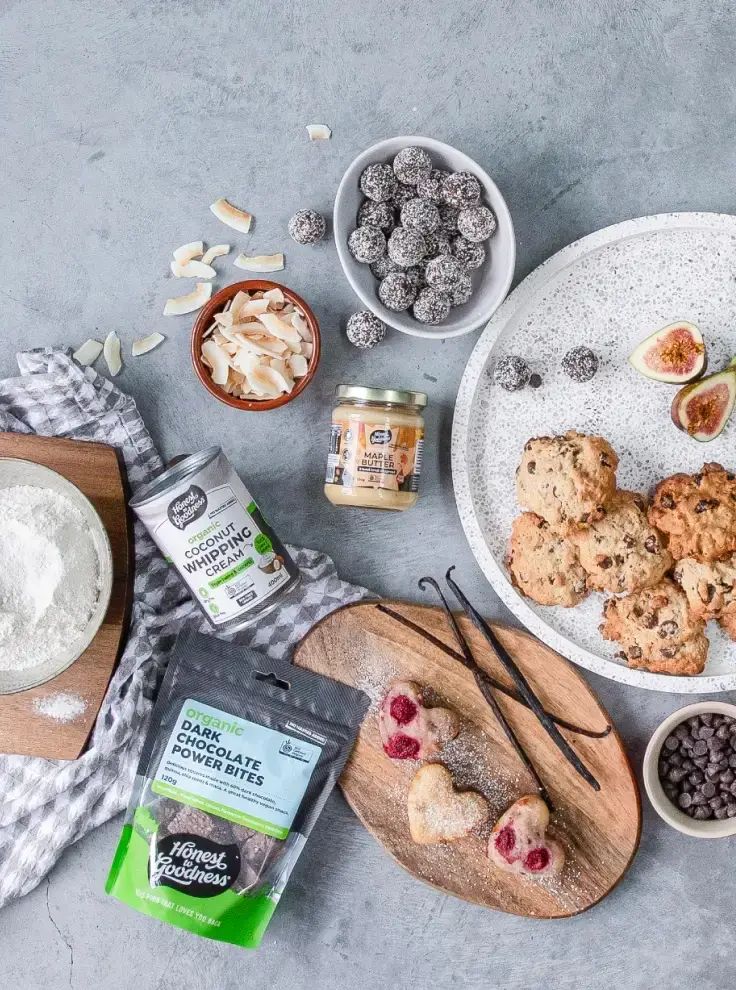Polenta of Millet & Amaranth with Pumpkin, Sage & Garlic

Millet and amaranth polenta triangles topped with a divine pumpkin topping. This is one of those dishes that will take a little bit more work and time, but it’s a great "occasion" dish.
Recipe from Wholefood from the Ground Up by Jude Blereau.
- Lightly oil a 20 cm (8 in) square dish – about 1–1.5 cm (½– in) in height is ideal. Don’t worry if you don’t have exactly the right size, just choose one that will give you the depth of polenta you desire.
- Place the millet and amaranth in a medium-size saucepan. You are better off with a wider (but shallower) pan here. Cook over medium–high heat for 3–5 minutes, until you can smell a delicious nuttiness, taking care not to burn the grains. As they begin to heat, the amaranth will pop – you will need to take the pan off the heat and shake it regularly to not only cool it down a little and stop any burning, but also to redistribute the grains.
- Reduce the heat to low again, add the hot stock or water, taking care as it will bubble a bit as it hits the hot pan. Stir in a good pinch of salt, then cover, increase the heat to high and bring to the boil. Reduce the heat to low so no steam escapes the lid.
- Simmer for 40–50 minutes, until the liquid is all absorbed. Remove from the heat, take off the lid and cover with a piece of paper towel to absorb any excess moisture.
- Allow to stand for 5 minutes. Transfer the polenta to the prepared dish, smooth over the top, cover with a tea towel (dish towel) and set aside until cool enough to handle.
- When the polenta is cool, turn it out onto a chopping board and cut into 4 rows, then cut each row into 3 pieces. Cut each piece in half on the diagonal, giving you a total of 24 pieces. When ready to put the dish together, preheat the oven to 100°C (200°F). Line a baking tray with paper towel.
- Pat the bottom of the polenta triangles dry with paper towel – this helps prevent the polenta from sticking during cooking. Add enough olive oil to a large frying pan to cover the base well and place over high heat. When the oil is hot but not at all smoking, cook the polenta in batches so you don’t overcrowd the pan, for 5–6 minutes on each side or until golden. This takes longer than you think, and requires a high heat. Place the fried polenta triangles on the lined baking tray, then put in the oven to keep warm.
- For the pumpkin topping, heat the ghee in a 30 cm (12 in) frying pan over medium–high heat. (If you don’t have a pan as large as this, you are best cooking the pumpkin in 2 batches.) Add the pumpkin and cook, shaking the pan occasionally to prevent sticking, for 15 minutes or until cooked and well caramelised. When ready, remove from the pan and set aside.
- Add the butter to the pan and shake over medium heat for 1–2 minutes, until the butter melts and turns a light, nutty brown – don’t let it burn. Immediately add the garlic and sage, and shake the pan over the heat for 10–15 seconds or until the sage is crisp and the garlic is light golden. Remove from the heat, add the pumpkin and shake the pan to mix through (avoid stirring). Remove the polenta from the oven and transfer to a large plate. Spoon over the pumpkin, pour the sage and garlic butter over the top, then scatter with cheese and serve immediately.
Kitchen Notes
- The recipe calls for butter and ghee. When frying and caramelising the pumpkin, use ghee as it will withstand the high heat needed and will enable you to shake and turn the pumpkin easily. Butter will give you the best result when making the brown butter.
- Both the polenta triangles and pumpkin topping can be made in advance. Just warm them before making the sage and garlic butter.
- I usually make extra pumpkin topping (in another frying pan) and have that sitting in the fridge to use over the next couple of days.
- Using stock to cook the grain will increase the flavour, and if you use a bone stock it will increase the nutrient density as well.
Recipes and images from Wholefood from the Ground Up by Jude Blereau (Murdoch Books) $39.99 available now in all good bookstores and online.
SHORT DESCRIPTION
Millet and amaranth polenta triangles topped with a divine pumpkin topping. This is one of those dishes that will take a little bit more work and time, but it’s a great "occasion " dish.
Recipe from Wholefood from the Ground Up by Jude Blereau.
DESCRIPTION
- Lightly oil a 20 cm (8 in) square dish – about 1–1.5 cm (½– in) in height is ideal. Don’t worry if you don’t have exactly the right size, just choose one that will give you the depth of polenta you desire.
- Place the millet and amaranth in a medium-size saucepan. You are better off with a wider (but shallower) pan here. Cook over medium–high heat for 3–5 minutes, until you can smell a delicious nuttiness, taking care not to burn the grains. As they begin to heat, the amaranth will pop – you will need to take the pan off the heat and shake it regularly to not only cool it down a little and stop any burning, but also to redistribute the grains.
- Reduce the heat to low again, add the hot stock or water, taking care as it will bubble a bit as it hits the hot pan. Stir in a good pinch of salt, then cover, increase the heat to high and bring to the boil. Reduce the heat to low so no steam escapes the lid.
- Simmer for 40–50 minutes, until the liquid is all absorbed. Remove from the heat, take off the lid and cover with a piece of paper towel to absorb any excess moisture.
- Allow to stand for 5 minutes. Transfer the polenta to the prepared dish, smooth over the top, cover with a tea towel (dish towel) and set aside until cool enough to handle.
- When the polenta is cool, turn it out onto a chopping board and cut into 4 rows, then cut each row into 3 pieces. Cut each piece in half on the diagonal, giving you a total of 24 pieces. When ready to put the dish together, preheat the oven to 100°C (200°F). Line a baking tray with paper towel.
- Pat the bottom of the polenta triangles dry with paper towel – this helps prevent the polenta from sticking during cooking. Add enough olive oil to a large frying pan to cover the base well and place over high heat. When the oil is hot but not at all smoking, cook the polenta in batches so you don’t overcrowd the pan, for 5–6 minutes on each side or until golden. This takes longer than you think, and requires a high heat. Place the fried polenta triangles on the lined baking tray, then put in the oven to keep warm.
- For the pumpkin topping, heat the ghee in a 30 cm (12 in) frying pan over medium–high heat. (If you don’t have a pan as large as this, you are best cooking the pumpkin in 2 batches.) Add the pumpkin and cook, shaking the pan occasionally to prevent sticking, for 15 minutes or until cooked and well caramelised. When ready, remove from the pan and set aside.
- Add the butter to the pan and shake over medium heat for 1–2 minutes, until the butter melts and turns a light, nutty brown – don’t let it burn. Immediately add the garlic and sage, and shake the pan over the heat for 10–15 seconds or until the sage is crisp and the garlic is light golden. Remove from the heat, add the pumpkin and shake the pan to mix through (avoid stirring). Remove the polenta from the oven and transfer to a large plate. Spoon over the pumpkin, pour the sage and garlic butter over the top, then scatter with cheese and serve immediately.
Kitchen Notes
- The recipe calls for butter and ghee. When frying and caramelising the pumpkin, use ghee as it will withstand the high heat needed and will enable you to shake and turn the pumpkin easily. Butter will give you the best result when making the brown butter.
- Both the polenta triangles and pumpkin topping can be made in advance. Just warm them before making the sage and garlic butter.
- I usually make extra pumpkin topping (in another frying pan) and have that sitting in the fridge to use over the next couple of days.
- Using stock to cook the grain will increase the flavour, and if you use a bone stock it will increase the nutrient density as well.
Recipes and images from Wholefood from the Ground Up by Jude Blereau (Murdoch Books) $39.99 available now in all good bookstores and online.
INGREDIENTS
Triangles
¼ cup organic amaranth
¾ cup organic millet
3 cups hot stock or water (750ml)
Pinch of sea salt, to taste
Organic extra virgin olive oil for frying, plus extra to grease
Grated parmesan, pecorino or romano cheese, to serve
Pumpkin Topping 1½ (generous) tbsp organic ghee
750g butternut pumpkin (squash), peeled, seeded and cut into 2cm dice
40g organic butter
5 garlic cloves, halved lengthways, then thinly sliced
20 sage leaves, or more if very small
Method










